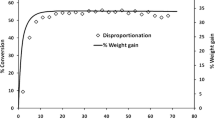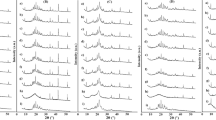Abstract
The solid-state properties of pharmaceutical salts, which are dependent on the counterion used to form the salt, are critical for successful development of a stable dosage form. In order to better understand the relationship between counterion and salt properties, 11 salts of procaine, which is a base, were synthesized and characterized using a variety of experimental and computational methods. Correlations between the various experimental and calculated physicochemical properties of the salts and counterions were probed. In addition to investigating the key factors affecting solubility, the hygroscopicity of the crystalline salts was studied to determine which solid-state and counterion properties might be responsible for enhancements in moisture uptake, thus providing the potential for adverse chemical stability. Multivariate principal components and partial least squares projection to latent structures analyses were performed in an attempt to establish predictive models capable of describing the relationships between these characteristics and both measured and calculated properties of the counterion and salt. Some success was achieved with respect to modeling crystalline salt solubility and the glass transition temperature of the amorphous salts. Through the modeling, insight into the relative importance of various descriptors on salt properties was achieved. The solid-state properties of crystalline and amorphous salts of procaine are highly dependent on the nature of the counterion. Important properties including aqueous solubility, melting point, hygroscopicity, and glass transition temperature were found to vary considerably between the different salts.









Similar content being viewed by others
References
Ware EC, Lu DR. An automated approach to salt selection for new unique trazodone salts. Pharm Res. 2004;21(1):177–84.
Black SN, Collier EA, Davey RJ, Roberts RJ. Structure, solubility, screening, and synthesis of molecular salts. J Pharm Sci. 2007;96(5):1053–68.
Gould PL. Salt selection for basic drugs. Int J Pharm. 1986;33(1–3):201–17.
Gu L, Strickley RG. Preformulation salt selection—physical property comparisons of the tris(hydroxymethyl)aminomethane (tham) salts of 4 analgesic antiinflammatory agents with the sodium-salts and the free acids. Pharm Res. 1987;4(3):255–7.
Jones HP, Davey RJ, Cox BG. Crystallization of a salt of a weak organic acid and base: solubility relations, supersaturation control and polymorphic behavior. J Phys Chem B. 2005;109(11):5273–8.
Morris KR, Fakes MG, Thakur AB, Newman AW, Singh AK, Venit JJ, et al. An integrated approach to the selection of optimal salt form for a new drug candidate. Int J Pharm. 1994;105(3):209–17.
O'Connor KM, Corrigan OI. Preparation and characterisation of a range of diclofenac salts. Int J Pharm. 2001;226(1–2):163–79.
O'Connor KM, Corrigan OI. Comparison of the physicochemical properties of the N-(2-hydroxyethyl) pyrrolidine, diethylamine and sodium salt forms of diclofenac. Int J Pharm. 2001;222(2):281–93.
Tong W-Q, Whitesell G. In situ salt screening—a useful technique for discovery support and preformulation studies. Pharm Dev Technol. 1998;3(2):215–23.
Huang LF, Tong WQ. Impact of solid state properties on developability assessment of drug candidates. Adv Drug Deliv Rev. 2004;56(3):321–34.
Bastin RJ, Bowker MJ, Slater BJ. Salt selection and optimisation procedures for pharmaceutical new chemical entities. Org Process Res Dev. 2000;4(5):427–35.
Datta S, Grant DJW. Crystal structures of drugs: advances in determination, prediction and engineering. Nat Rev Drug Discov. 2004;3(1):42–57.
Chow K, Tong HHY, Lum S, Chow AHL. Engineering of pharmaceutical materials: an industrial perspective. J Pharm Sci. 2008;97(8):2855–77.
Giron D. Characterisation of salts of drug substances. J Therm Anal Calorim. 2003;73(2):441–57.
Agharkar S, Lindenbaum S, Higuchi T. Enhancement of solubility of drug salts by hydrophilic counterions—properties of organic salts of an antimalarial drug. J Pharm Sci. 1976;65(5):747–9.
Berge SM, Bighley LD, Monkhouse DC. Pharmaceutical aalts. J Pharm Sci. 1977;66(1):1–19.
Anderson BD, Conradi RA. Predictive relationships in the water solubility of salts of a nonsteroidal anti-inflammatory drug. J Pharm Sci. 1985;74(8):815–20.
Chowhan ZT. Ph-solubility profiles of organic carboxylic-acids and their salts. J Pharm Sci. 1978;67(9):1257–60.
Fini A, Feroci G, Fazio G. Effects of the counter-ions on the properties of diclofenac salts. Int J Pharm Adv. 1996;1(3):269–84.
Parshad H, Frydenvang K, Liljefors T, Sorensen HO, Larsen C. Aqueous solubility study of salts of benzylamine derivatives and p-substituted benzoic acid derivatives using X-ray crystallographic analysis. Int J Pharm. 2004;269(1):157–68.
Blagden N, de Matas M, Gavan PT, York P. Crystal engineering of active pharmaceutical ingredients to improve solubility and dissolution rates. Adv Drug Deliv Rev. 2007;59(7):617–30.
Yu L. Amorphous pharmaceutical solids: preparation, characterization and stabilization. Adv Drug Deliv Rev. 2001;48(1):27–42.
Tong P, Zografi G. Solid-state characteristics of amorphous sodium indomethacin relative to its free acid. Pharm Res. 1999;16(8):1186–92.
Tong P, Taylor LS, Zografi G. Influence of alkali metal counterions on the glass transition temperature of amorphous indomethacin salts. Pharm Res. 2002;19(5):649–54.
Towler CS, Li TL, Wikstrom H, Remick DM, Sanchez-Felix MV, Taylor LS. An investigation into the influence of counterion on the properties of some amorphous organic salts. Mol Pharm. 2008;5(6):946–55.
Guerrieri P, Jarring K, Taylor LS. Impact of counterion on the chemical stability of crystalline salts of procaine. J Pharm Sci. 2010. doi:10.10002/jps.22009.
Salameh AK, Taylor LS. Deliquescence in binary mixtures. Pharm Res. 2005;22(2):318–24.
Brunauer S, Emmett PH, Teller E. Adsorption of gases in multimolecular layers. J Am Chem Soc. 1938;60:309–19.
Jain N, Yalkowsky SH. Estimation of the aqueous solubility I: application to organic nonelectrolytes. J Pharm Sci. 2001;90(2):234–52.
Pinho SP, Macedo EA. Representation of salt solubility in mixed solvents: a comparison of thermodynamic models. Fluid Phase Equilib. 1996;116:209–16.
Martinez F, Gomez A. Thermodynamic study of the solubility of some sulfonamides in octanol, water, and the mutually saturated solvents. J Solution Chem. 2001;30(10):909–23.
Hildebrand JH, Prausnitz JM, Scott RL. Regular and related solutions; the solubility of gases, liquids and solids. New York: Van Nostrand Reinhold; 1970.
Graziano G. Benzene solubility in water: a reassessment. Chem Phys Lett. 2006;429(1–3):114–8.
Schravendijk P, van der Vegt NFA. From hydrophobic to hydrophilic solvation: an application to hydration of benzene. J Chem Theory Comput. 2005;1(4):643–52.
Ghasemi J, Saaidpour S. QSPR prediction of aqueous solubility of drug-like organic compounds. Chem Pharm Bull. 2007;55(4):669–74.
Chen XQ, Cho SJ, Li Y, Venkatesh S. Prediction of aqueous solubility of organic compounds using a quantitative structure-property relationship. J Pharm Sci. 2002;91(8):1838–52.
Gao H, Shanmugasundaram V, Lee P. Estimation of aqueous solubility of organic compounds with QSPR approach. Pharm Res. 2002;19(4):497–503.
Jorgensen WL, Duffy EM. Prediction of drug solubility from structure. Adv Drug Deliv Rev. 2002;54(3):355–66.
Huuskonen J. Estimation of aqueous solubility for a diverse set of organic compounds based on molecular topology. J Chem Inf Comput Sci. 2000;40(3):773–7.
Huibers PDT, Katritzky AR. Correlation of the aqueous solubility of hydrocarbons and halogenated hydrocarbons with molecular structure. J Chem Inf Comput Sci. 1998;38(2):283–92.
Huuskonen J, Salo M, Taskinen J. Aqueous solubility prediction of drugs based on molecular topology and neural network modeling. J Chem Inf Comput Sci. 1998;38(3):450–6.
Mitchell BE, Jurs PC. Prediction of aqueous solubility of organic compounds from molecular structure. J Chem Inf Comput Sci. 1998;38(3):489–96.
Huuskonen J, Salo M, Taskinen J. Neural network modeling for estimation of the aqueous solubility of structurally related drugs. J Pharm Sci. 1997;86(4):450–4.
Sutter JM, Jurs PC. Prediction of aqueous solubility for a diverse set of heteroatom-containing organic compounds using a quantitative structure-property relationship. J Chem Inf Comput Sci. 1996;36(1):100–7.
Nelson TM, Jurs PC. Prediction of aqueous solubility of organic compounds. J Chem Inf Comput Sci. 1994;34(3):601–9.
Bodor N, Huang MJ. A new mehotd for the estimation of the aqueous solubility of organic compounds. J Pharm Sci. 1992;81(9):954–60.
Klopman G, Wang S, Balthasar DM. Estimation of aqueous solubility of organic molecules by the group contribution approach—application to the study of biodegradation. J Chem Inf Comput Sci. 1992;32(5):474–82.
Patil GS. Correlation of aqueous solubility and octanol-water partition coefficient based on molecular structure. Chemosphere. 1991;22(8):723–38.
Tantishaiyakul V. Prediction of the aqueous solubility of benzylamine salts using QSPR model. J Pharm Biomed Anal. 2005;37(2):411–5.
Tantishaiyakul V. Prediction of aqueous solubility of organic salts of diclofenac using PLS and molecular modeling. Int J Pharm. 2004;275(1–2):133–9.
Parshad H, Frydenvang K, Liljefors T, Larsen CS. Correlation of aqueous solubility of salts of benzylamine with experimentally and theoretically derived parameters. A multivariate data analysis approach. Int J Pharm. 2002;237(1–2):193–207.
Vippagunta SR, Brittain HG, Grant DJW. Crystalline solids. Adv Drug Deliv Rev. 2001;48(1):3–26.
Hancock BC, Zografi G. Effects of solid-state processing on water vapor sorption by aspirin. J Pharm Sci. 1996;85(2):246–8.
Salekigerhardt A, Ahlneck C, Zografi G. Assessment of disorder in crystalline solids. Int J Pharm. 1994;101(3):237–47.
Guerrieri P, Salameh AK, Taylor LS. Effect of small levels of impurities on the water vapor sorption behavior of ranitidine HCl. Pharm Res. 2007;24(1):147–56.
Van Campen L, Amidon GL, Zografi G. Moisture sorption kinetics for water-soluble substances. 1. Theoretical considerations of heat-transport control. J Pharm Sci. 1983;72(12):1381–8.
Zografi G. States of water associated with solids. Drug Dev Ind Pharm. 1988;14(14):1905–26.
Nicklasson M, Nyqvist H. Studies of the relationship between intrinsic dissolution rates and rates of water adsorption. Acta Pharm Suec. 1983;20(5):321–30.
Ross KD. Estimation of water activity in intermediate moisture foods. Food Technol. 1975;29(3):26–34.
Dittgen M, Durrani M, Lehmann K. Acrylic polymers. A review of pharmaceutical applications. S.T.P. Pharm Sci. 1997;7(6):403–37.
Ayers PW, Parr RG, Pearson RG. Elucidating the hard/soft acid/base principle: a perspective based on half-reactions. J Chem Phys. 2006;124(19):194107/1–194107/8.
Parr RG, Yang WT. Density-functional theory of the electronic structure of molecules. Annu Rev Phys Chem. 1995;46:701–28.
Parr RG, Von Szentpaly L, Liu SB. Electrophilicity index. J Am Chem Soc. 1999;121(9):1922–4.
Acknowledgements
The authors acknowledge AstraZeneca R&D Lund, Sweden for funding this research. Dr. Kjell Jarring is sincerely thanked for helpful discussions. Nathan Hesse is gratefully acknowledged for performing the solution calorimetry experiments.
Author information
Authors and Affiliations
Corresponding author
Rights and permissions
About this article
Cite this article
Guerrieri, P., Rumondor, A.C.F., Li, T. et al. Analysis of Relationships Between Solid-State Properties, Counterion, and Developability of Pharmaceutical Salts. AAPS PharmSciTech 11, 1212–1222 (2010). https://doi.org/10.1208/s12249-010-9499-4
Received:
Accepted:
Published:
Issue Date:
DOI: https://doi.org/10.1208/s12249-010-9499-4




